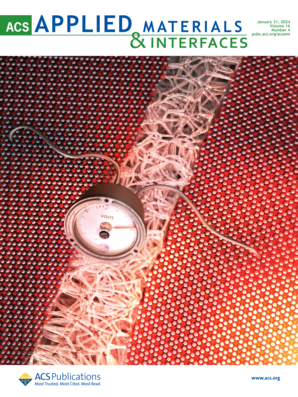High-Performance Cr8O21 Cathode Materials with MnO2 as an Activator for High-Energy-Density Lithium Primary Batteries
IF 8.3
2区 材料科学
Q1 MATERIALS SCIENCE, MULTIDISCIPLINARY
引用次数: 0
Abstract
Chromium oxides (Cr8O21) have attracted wide application due to their high theoretical capacity and high voltage for lithium primary batteries. However, Cr8O21 is usually prepared by pyrolysis of a CrO3 precursor and suffers from low capacity and poor rate capability due to the fusion of CrO3 during the high-temperature reaction process. Herein, MnO2 was investigated as an activator to study its impact on the electrochemical properties of Cr8O21, which significantly changed with the addition of MnO2 during the calcination process. With the addition of MnO2, the discharge capacity and rate capability of the reaction products (Cr8O21-M) were dramatically improved compared with those of pure Cr8O21. This improvement is attributed to the superior lithium-ion diffusion kinetics caused by the uniform surface structure and porous features, which reduce the charge transfer resistance. As a result, Cr8O21-M10 exhibited an excellent discharge specific capacity of 388 mAh g–1 at 0.1C with discharge voltage plateaus of about 3.0 V (vs Li+/Li), reaching an energy density of 1223 Wh kg–1 based on the cathode material. In addition, Cr8O21-M showed remarkable rate performance, enabling a high-capacity retention of about 70% at 5C. Therefore, it is essential to add an activator agent during the preparation of Cr8O21, which offers a promising avenue for the development of high-energy-density and high-rate-capability Li/Cr8O21 primary batteries.

以二氧化锰为活化剂的高性能Cr8O21正极材料高能量密度锂原电池
铬氧化物(Cr8O21)因其理论容量高、电压高而在锂一次电池中得到广泛应用。然而,Cr8O21 通常是通过热解 CrO3 前驱体制备的,由于在高温反应过程中 CrO3 会发生熔融,因此存在容量低和速率能力差的问题。本文研究了 MnO2 作为活化剂对 Cr8O21 电化学特性的影响,在煅烧过程中加入 MnO2 后,Cr8O21 的电化学特性发生了显著变化。与纯 Cr8O21 相比,添加 MnO2 后,反应产物(Cr8O21-M)的放电容量和速率能力得到了显著提高。这种改善归功于均匀的表面结构和多孔特征所带来的卓越的锂离子扩散动力学,从而降低了电荷转移阻力。因此,Cr8O21-M10 在 0.1C 时的放电比容量为 388 mAh g-1,放电电压高原约为 3.0 V(对 Li+/Li),能量密度达到 1223 Wh kg-1。此外,Cr8O21-M 还显示出卓越的速率性能,在 5C 时可保持约 70% 的高容量。因此,在制备 Cr8O21 的过程中添加活化剂至关重要,这为开发高能量密度和高倍率能力的锂/Cr8O21 一次电池提供了一条前景广阔的途径。
本文章由计算机程序翻译,如有差异,请以英文原文为准。
求助全文
约1分钟内获得全文
求助全文
来源期刊

ACS Applied Materials & Interfaces
工程技术-材料科学:综合
CiteScore
16.00
自引率
6.30%
发文量
4978
审稿时长
1.8 months
期刊介绍:
ACS Applied Materials & Interfaces is a leading interdisciplinary journal that brings together chemists, engineers, physicists, and biologists to explore the development and utilization of newly-discovered materials and interfacial processes for specific applications. Our journal has experienced remarkable growth since its establishment in 2009, both in terms of the number of articles published and the impact of the research showcased. We are proud to foster a truly global community, with the majority of published articles originating from outside the United States, reflecting the rapid growth of applied research worldwide.
 求助内容:
求助内容: 应助结果提醒方式:
应助结果提醒方式:


